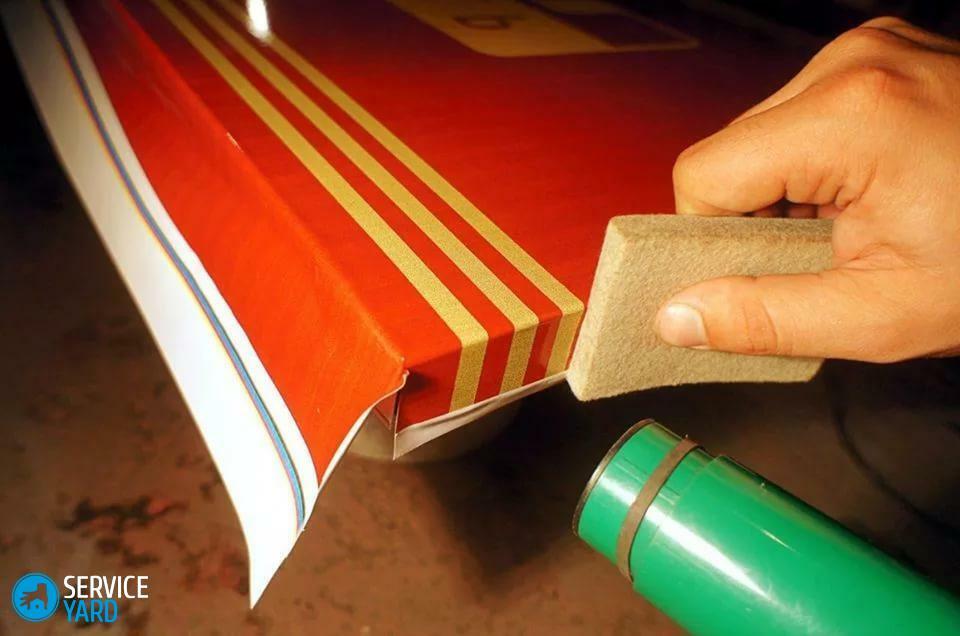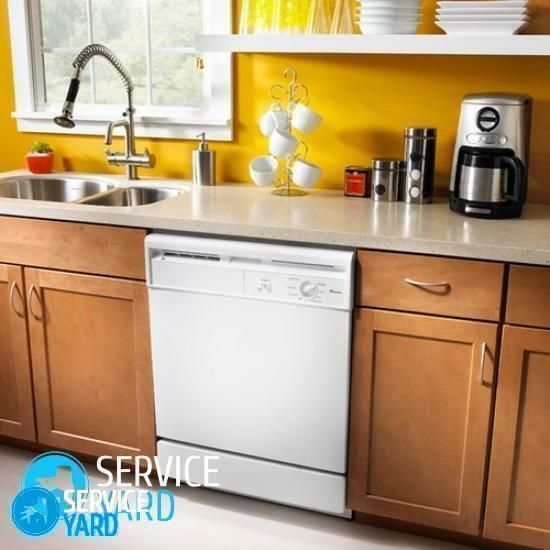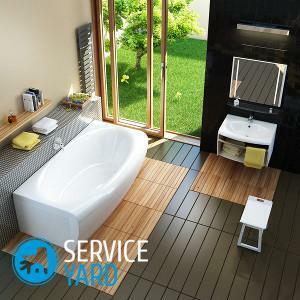
- How to clean the bath of stale dirt at home?
- How to choose the right cleaning agent?
- How to clean the bath of lime, without damaging the enamel?
- How do I clean a bath at home with soda and vinegar?
Bright white plumbing simply transforms the room. However, over time, tap water that is aggressive in its composition, frequent washing and washing, improper care do their job - a gray coating appears on the bathroom, rusty stains that call into question all the sanitation at home. The burning question of how to clean the bathtub in white at home, sounds like a lot, because the widely advertised means for bath cleaning are sometimes absolutely useless, and in some cases, even can ruin the plumbing permanently. In addition, all chemicals are unsafe, especially for young children. But our grandmothers knew how to wash the bath to become white, and did not use aggressive chemicals. In the article, we will describe how to clean the tub, depending on the material of the sanitary ware and the type of contamination, because each type of bath requires special care.
to the contents ↑How to wash the tub of stale dirt at home?
To think about the care of plumbing is necessary at the time of its purchase, because different surfaces require their own special conditions, cleaning methods and means.
Here it is necessary to consider the following:
- Popular acrylic baths for today must be cleaned only with special tools that are not that cheap.
- Some household products are designed for soft cleaning, so they can not remove stains and rust, regardless of the material of the plumbing cup cover.
- Aggressive agents, capable of eliminating any contamination, including cleaning the bath of stale dirt at home, can destroy the coating of the bath after 2-3 applications.
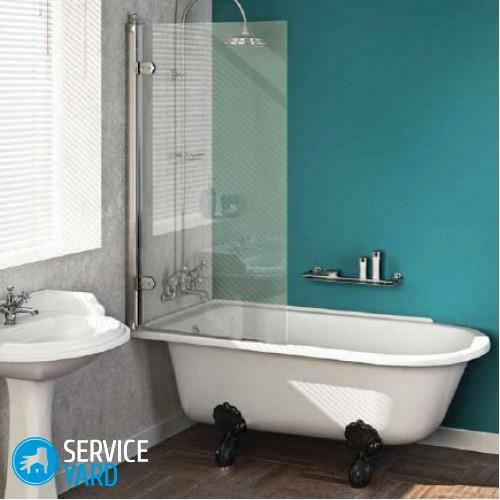
Important! Similarly, the situation develops with the use of a brush for cleaning plumbing: if acrylic or enameled plumbing can only be washed with a soft rag or sponge, then a cast iron bath can be cleaned with a stiffer brush.
Do not use metal brushes to clean the plumbing, so as not to scratch or tear off the coating.
Preparation for cleaning
Before cleaning the bathtub to white at home, it is necessary:
- to choose an effective safe tool that is suitable for the type of plumbing covering;
- it is obligatory to familiarize with structure and the instruction on application.
Important! Remember that special acid formulations and powders with an abrasive are not suitable for all types of coatings. Sometimes it is better to turn to alternative people's ways and means.
How do I clean a cast iron bathtub in white at home?
Cast iron baths have been manufactured for many years and are in great demand. Of course, they are heavy, but reliable, especially old samples. The peculiarity of old cast-iron baths is also the fact that dirt is very quickly clogged in numerous microcracks, and it is necessary to clean it quite often, and even with the use of great physical efforts. However, modern models of cast-iron baths are less heavy, more practical, and thanks to a special coating, they are easier to clean - any acid-containing substances are suitable for cleaning such a bath.
If you do not want to buy expensive store tools or you are allergic to "chemistry", then use simple folk methods, time-tested and not lost popularity these days:
- Cleaning powders. For a cast-iron font, any cleaning powders will fit, and if not soiled, even a washing powder. On the wet surface of the sanitary ware, rub the powder and leave for 20 minutes. After that, in a circular motion, remove all dirt with a brush, rinse abundantly with warm water.
- Soda. Clean the bath before white soda at home is simple. To do this, use soda ash and baking soda in a 1: 1 ratio. On a damp surface, apply a soda mixture and leave for 30 minutes. After half an hour, treat the surface with a mixture of powdered bleach and vinegar, leave for another 40 minutes. After cleaning, rinse thoroughly and wipe dry.
- Ammonium alcohol. Prepare the following mixture: 1 tbsp.spoon of baking soda + 1 teaspoon of ammonia. The prepared powder is applied with a sponge to the surface of the font and leave for half an hour. After this, rinse the mixture with warm water.
- Bleach. Mix baking soda with bleach powder in a 1: 1 ratio. The resulting mixture is applied to the surface of the bath, and after 40 minutes, rinse with warm water. The plaque will depart immediately after the powder is washed off, further cleaning will not be required.
How do I clean the steel bathtub?
Steel fonts, though practical than acrylic, but also do not like abrasive powders. Use the following simple and easy-to-clean tools for cleaning:
- Liquid detergents. Choose soft detergent products in the form of a gel. Put the agent on the surface and rinse with warm water after 5-10 minutes. Remove any stubborn dirt with a dishwashing detergent.
- Soda. Soak the surface of the font and treat it with calcined or baking soda. Blend the mixture immediately after cleaning. Soda effectively removes and rust, so it is this tool is universal to clean the bath of stale dirt at home.
- Ammonium alcohol. Prepare the following solution: 1 glass of water - 1 tbsp.spoon of ammonia. With a solution, treat the surface and after 10 minutes rinse with water. Pollution is removed and no additional cleaning is required.
Important! The coating of steel baths does not tolerate temperature effects. Therefore, when choosing a detergent, pay attention to the fact that the product does not heat up on contact with water. Work with chemicals only in gloves, since even soda in the wrong proportions can cause a burn.
How do I clean the enamelled bathtub?
This type of font is used most often, as enameled baths withstand temperatures as high as 75 degrees, very easy to clean and almost universal in cleaning.
Important! It should be remembered, like any enamel, the surface does not tolerate metal and abrasive brushes. When using coarse brushes, the enamel becomes rough and not respectable, moreover, when the coating is erased, cracks are formed.
To remove the enamelled bath from undesirable effects, use the following cleaning agents:
- Baking soda. Clean the enamel with baking soda and then rinse with water. In case of severe dirt, repeat the procedure 2-3 times.
- Citric acid. Concentrate a solution of citric acid, treat the surface of the font, and after 15-20 minutes rinse.
- Household soap + ammonia. Wipe the laundry soap on a grater( 0.5 cup).Soak the shavings in water for 5 minutes to get a homogeneous liquid mixture. Add 3-5 drops of ammonia to the solution. Prepare the mixture with enamel. After 15 minutes, rinse with water. All the dirt will be wiped off without much effort.
- Detergents for plumbing. In household chemistry stores, you will buy detergents for cleaning kitchen stoves and sanitary ware, which will cope with the bloom, grease and rust. The most popular are: Cif, Comet. Apply the product to the enamel, after 15 minutes, rinse with water. Pollution is best removed after thorough cleaning before flushing. For safety of a covering it is better to use liquid cleaners.
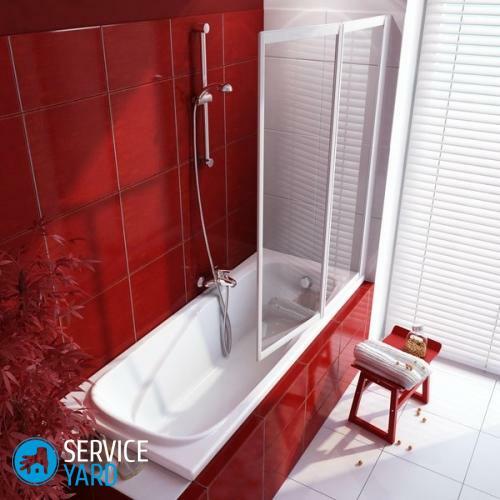
Important! To keep the enamel coating for many years, clean regularly. With this approach, you not only keep the cover in its original form, but also prevent the multiplication of bacteria.
Is it possible to wash an acrylic bath with soda?
The most difficult to care for are acrylic bathtubs. When cleaning, you can not use:
- Abrasives.
- Strongly aggressive chemicals.
- Rigid brushes.
Important! All these products can forever ruin even a new acrylic bath.
As a rule, the plaque does not accumulate on the acrylic coating, and the yellowing formed can easily be cleaned with detergents. In addition, it is necessary to distinguish between different types of coatings: baths made of acrylic sheets and fonts with acrylic spraying:
- In the bathrooms with spraying, with improper care, cracks can form. The sputtering itself can be erased, even by aggressive cleaning agents, not just a rough brush.
- Products made of cast acrylic are much more practical and it will be much easier to clean the bathtub to white at home from such material. But choosing a new model, keep in mind that the casting plumbing cup will cost an order of magnitude more expensive.
For the care of a delicate surface, use:
- Mild detergents, preferably gels. Apply the product to the surface and after 5-10 minutes rinse with water.
- You can also use a dishwashing detergent( with slight impurities).
To clean the bath to white at home, use the following:
- Lemon juice or acid. On one bath use 2 cups of lemon juice or 1 bag of citric acid. Treat the coating with juice or a concentrated acid solution. After 10-15 minutes the contamination will go away together with the washed out water. The citric acid is practically harmless to any enamel, unlike other acids.
- Vinegar. Paper napkins moisten in a 9% solution of vinegar and spread on the entire surface of the font. Leave the bath for 2-3 hours to soak, and then vinegar is abundant and thoroughly rinse with water.
Advice:
- Clean the surface of the acrylic bath not more than once in two weeks, and disinfect - once a week.
- If you do not have a special disinfectant, then use a normal laundry soap. Apply soap solution to the surface of the acrylic font, and then rinse.
How to choose the right cleaning agent?
On the shelves of hardware stores you can now find gels, sprays, powders for cleaning plumbing. They quickly remove plaque, rust, disinfect, and some also protect the bath for a while from new contaminants.
Selection criteria for
What means to use for plumbing depends on the following factors:
- Type of plumbing covering.
- Type of contamination.
- Security.
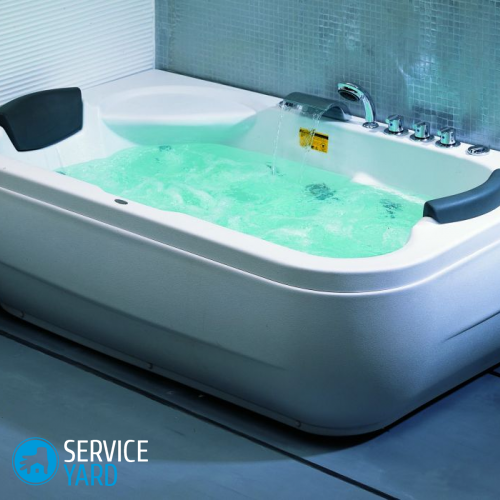
Important! If the plumbing has not seen the brush for a long time, and the coating has darkened from time, then a simple ordinary remedy is unlikely to save. In this case, a strong chemical agent containing acid is needed. If the plumbing is new and just needs regular cleaning, then you need to choose a less aggressive means.
Types of contamination
The surface of the bath is contaminated for various reasons, in particular:
- Simple plaque is a kind of dirt that remains when washing. It is a skin discharge, skin particles mixed with a soap solution. To remove such a touch is simple enough - flush the contamination with hot water and a sponge each time after taking a bath.
- Calcareous plaque. If in your area hard water containing various salts, then in the course of time, a yellowish or white crumbling plaque will be deposited on the surface of all sanitary ware. It must be removed with the help of special products containing acids that are capable of dissolving calcium compounds.
- Scouring from detergents. The compounds that make up shampoos, shower gels, soaps, over time, form a gray coating on the surface of the bath. By simple means, it will not be possible to get rid of it. Here you have to work hard to clean the bathtub in white at home.
- Rust. This pollution appears due to the high iron content in the water. This type of plaque refers to hard-to-remove impurities, for the removal of which special means are required.
- Yellowness on the enamel. This pollution settles on the surface of sanitary ware, if there are old water pipes in the house, from which various tap water biofilms and oxides are poured.
- Old enamel. This type of contamination is very difficult to clean, since the surface is covered with small cracks in which the dirt has eaten up. Sometimes a complete bath replacement or restoration is required.
- Specific pollution. This type includes stains from paint or other building materials that hit the surface during repairs, as well as mold. Remove specific contaminants with solvents and antifungal agents.
Additional factors
The type of coating also influences the choice of the preparation very much. For example:
- acrylic can not be exposed to abrasive agents, only gels and pastes can be used;
- dense enamel surface is not afraid of virtually all available detergents.
Important! Do not forget about safety, especially if the house is children, allergic people or just people with sensitive skin. Therefore, after using a detergent, be sure to rinse it off with a soft cloth or sponge, and rinse with water.
Application rules for
When using chemical household products, observe the following rules:
- Apply the product strictly following the instructions.
- Do not use the product more than once a week.
- Only use gloves when handling chemicals.
- Do not keep aggressive chemicals on the enamel for too long.
- Clean the surface gently and gently, applying lightly, only with deep soiling.
- Wash off with warm( not hot) water.
- For acrylic bathtubs, use only special products designed for these coatings.
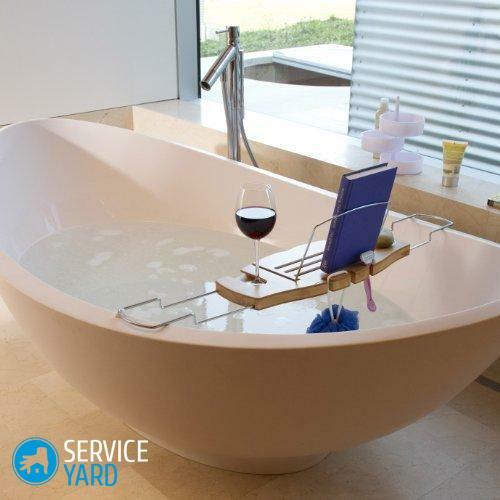
Important! The best means for cleaning is that which does not require special effort, easy to use, does not harm the coating and is safe for people and pets.
Popular brands
The following are the most effective and sparing tools:
- "Cif".Use a gel - it is preferable. The cream-like "Cif Active" will remove traces of lime scale and rust. Use this product both for the care of metal parts of sanitary ware, and behind the mirror surfaces, as well as ceramic tiles.
- "Comet".Products in the form of gel is suitable not only for sanitary ware, but also for all kitchen surfaces. For baths is best suited series "7 days of cleanliness."Such a cleanser will help to get rid of complex dirt, even quickly clean the tub to white at home. And the effect of purity will last much longer.
- "Cillit".Use for regular cleaning. With a calcareous coating, rust, this remedy can not cope.
- "Domestos".Liquid detergent or products in the form of gel is suitable for regular maintenance. The remedy with dirt of medium complexity and not particularly neglected will cope. The only drawback is the smell of chlorine. You can not use the products on metal parts of sanitary ware, covered with any spraying.
- "Pemolux".Ideal for cleaning enamel baths, as the product includes soda. For regular cleaning can be used for old baths, since the powder slightly scratches the enamel.
- "San Klin", "Triton", Mr. Chister "- are designed for baths covered with acrylic. The product does not contain acids, strong aggressive substances and does not scratch the surface.
Useful advices:
- Do not use toilet cleaning products for the bathroom, as these products are too aggressive.
- Do not use products containing hydrochloric acid, alkalis, aldehydes, oxalic acid, as these chemicals corrode enamel.
- Use mustard powder to clean contaminated areas of the enamel. Prepare the powder from the powder and wipe the contaminated surface.
- To clean the bath to white at home from any contamination, use the recipe for lazy people: put water in a font and dissolve 0.5 liters of vinegar or 100 grams of citric acid, leave a bath for the night, and rinse the water in the morning and rinse the surface.
How to clean the bath of lime deposits without damaging the enamel?
Home products can be used to prepare mixtures that will help to relieve plumbing from limescale and rust. Here are a few recipes.
Recipe # 1
Mix the borax( sodium tetraborate) with table vinegar in equal proportions.
Recipe No.2
Salt and warmed vinegar mix until the formation of gruel.
Recipe №3
Mix salt and turpentine in equal quantities.
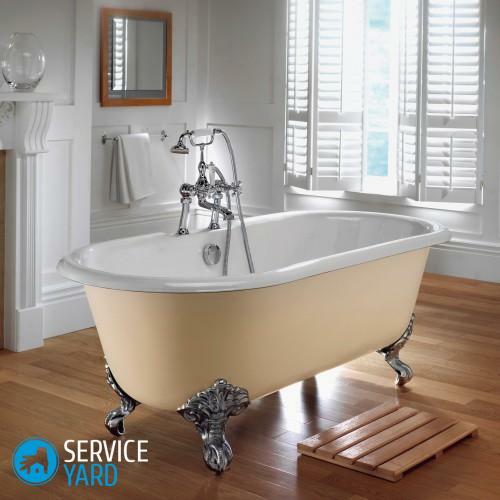
Method of use of any product:
Apply the prepared mixtures to the stain, wipe the plaque with a cloth.
Important! To remove rust, use the following tools:
- Ammonia alcohol. Dissolve alcohol in water and apply solution to the problem area. After 10-15 minutes rinse with water.
- Lemon juice. On the stains of rust squeeze out the lemon juice, after 10-15 minutes rinse the surface.
- Salt + vinegar. Wipe the rust with a mixture of vinegar and salt.
How to clean the bath at home with soda and vinegar?
Many housewives are increasingly abandoning the store chemicals and prefer more sparing formulations that allow the bath to return to shining whiteness and purity, because the advantages of folk remedies are obvious:
- Availability.
- Security.
- Softer effect on enamel.
- Low price.
- Ease of use.
- Persistent effect.
Of course, every housewife has her own recipe, but as a rule, all the products are based on the same products.
Soda
Excellent whitening agent is used to clean almost all contaminants, except lime. Soda is absolutely harmless, does not have an unpleasant smell. It perfectly removes fat, yellowness, neutralizes the most persistent soiling.
Important! If you want to clean the bath to shine, then use soda ash, which is sold in hardware stores. But be sure to protect your hands before using soda with gloves .
Tips for use:
- To remove a small deposit, rub the soda over the surface of the sanitary ware with a damp soft sponge or brush.
- Leave the font to soak for an hour, then rinse the product with a jet of warm water( not hot).
- To remove a strong coating, mix the soda ash with a food analogue in a 1: 1 ratio, and proceed as follows:
- Take the prepared mixture and add a little water to it until it becomes a gruel.
- Apply gruel to a dirty surface.
- Leave the font for 20-30 minutes.
- Connect 0.5 cups of vinegar and 0.5 cups of bleach.
- Apply the resulting composition to the soda layer.
- Leave the remedy for 30-40 minutes.
- Wipe the surface of the sanitary ware with a soft washcloth or sponge.
- Rinse the bath thoroughly with water.
Important! To whiten the bath, soak the laundry soap and mix it with soda. Prepared mixture dilute 5 drops of ammonia and 3-5 st.spoons of water. Finished mortar on the surface and leave for one hour. After - rinse with warm water.
Vinegar
To defeat dirt and rust, use vinegar. However, before applying the acid, be sure to try its effects on the inconspicuous area of sanitary ware.
Use 9% vinegar as follows:
- Drink plenty of vinegar with plenty of napkins.
- Vydelite surface of the bath with a napkin.
- Leave the bath itself cleaned, within 3-5 hours.
- Remove paper wipes.
- Rinse the plumbing with water.
Important! Clean the font with soda and vinegar at the same time, acting as follows:
- Moisten the bath, generously sprinkle with calcined or baking soda.
- Leave the font to soak for several hours, then generously pour the surface with vinegar.
- Remember that this cleaning should be done with open windows and doors.
This method is suitable for cast iron and enamel baths.
Expensive and aggressive means will remain in the past if you use soda and vinegar. You will not only save money, time and energy, but also protect yourself and the household from the harm of "chemistry".However, remember that the presented folk recipes are applicable only to cast iron and iron structures, and modern plastic inserts are very sensitive and can be damaged by aggressive substances. We hope that the information obtained, recommendations and advice will help you to decide on the issue, than to clean the bathtub in white at home, and you can maintain the ideal cleanliness and whiteness of all plumbing, without using harmful chemical compounds. Good luck!

